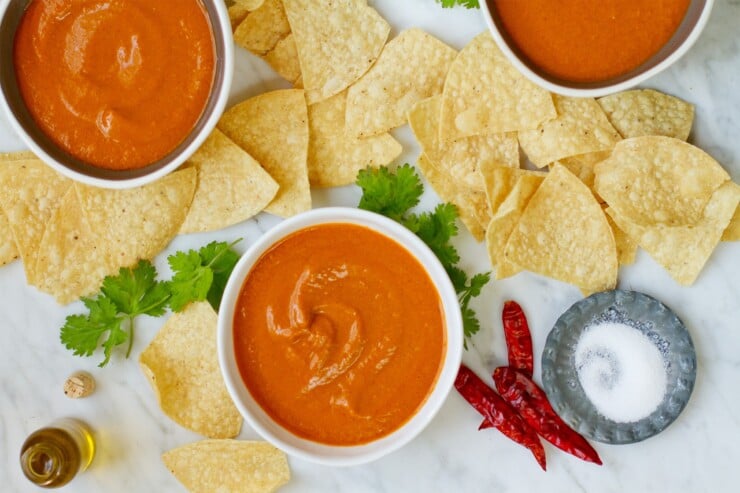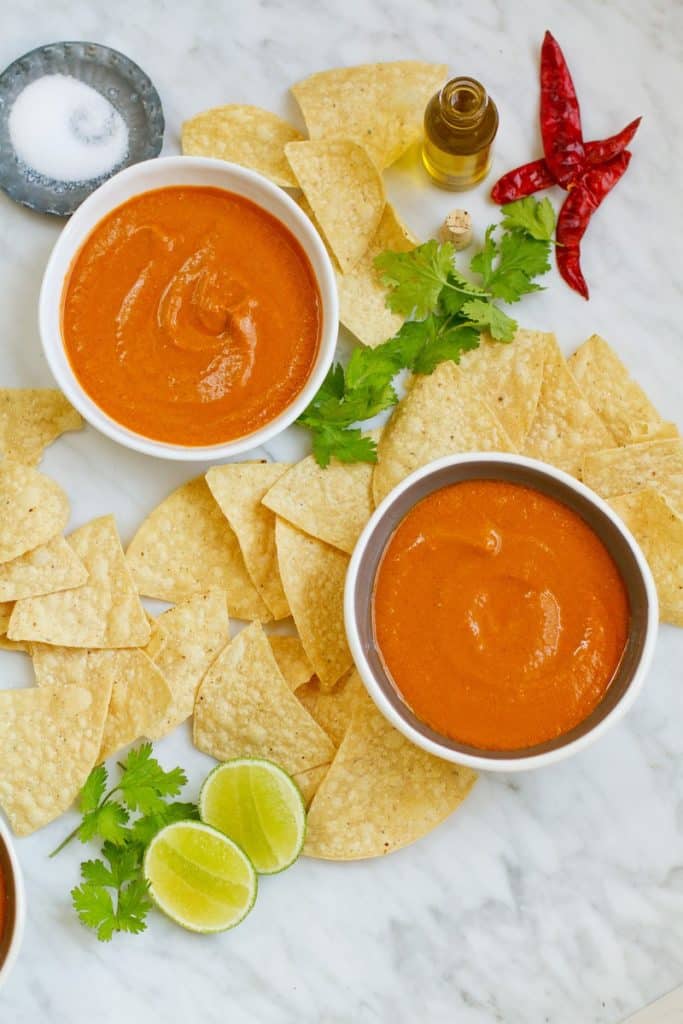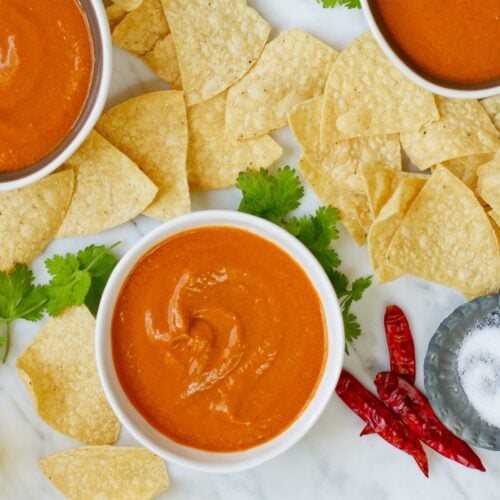We did it — we cracked the code. True, it was years ago, but I still do a little victory dance whenever I think about this Roasted Tomato Papalote Salsa Recipe. When I moved to San Francisco and in the first days of my life as a recipe tester, my then-boss was obsessed with figuring out how to make the Roasted Tomato Salsa from his favorite taqueria, Papalote Mexican Grill.

Why You’ll Love This Recipe
What is a great taco or burrito without an equally awesome salsa? Well, the Papalote salsa recipe is that. It’s hot but not too, balanced in its sweetness and tang, has a welcome char, and, most importantly, improves everything it touches. But don’t take my word, even Bobby Flay claimed the salsa was a “secret weapon” during an episode of “Beat Bobby Flay.”
We never got the official recipe from the Escobedos, and if you look at the label of their salsa jar (now for sale online and at Bay Area markets!), you’ll see they don’t have pumpkin seeds like we do. Even so, I stand by it being a great dupe. So, even if you don’t live near the taquería, you can still try it for yourself at home.
Recipe Ingredients
These are the ingredients you’ll need to prepare this Papalote Salsa Recipe:
- Roma tomatoes
- Dried chile de arbol
- Dried pasilla chile
- Shelled pumpkin or sunflower seeds
- Kosher Salt
- Granulated Sugar
- Water
- White wine vinegar
- Green onions (aka scallions)
- fresh cilantro leaves
How To Make This Recipe
These are the instructions to make this Papalote Salsa Recipe:
- Toast The Chiles: Arrange chiles on baking sheet and the pumpkin seeds in a small ovenproof pan and toast the chiles until fragrant and puffed, and the pepitas until golden brown.
- Char The Tomatoes: Broil the tomatoes until the skins are slightly charred.
- Simmer The Tomatoes: Place the roasted tomatoes and toasted chiles in a large stainless steel pan over high heat. Add the salt, sugar, and water and stir to combine. Bring to a boil, reduce the heat to low, and simmer, stirring often, until the mixture has reduced slightly and thickened.
- Finish The Salsa: Carefully place one-third to one-half of the mixture in a blender, add the toasted pumpkin seeds, scallions, and cilantro, remove the plug on the blender top so it lets off heat, then carefully blend until smooth.
Pour the salsa into an airtight resealable container, taste, and add more salt, pepper, or vinegar, as desired. Refrigerate uncovered until thoroughly chilled before serving, at least 2 hours.
What To Serve With This Recipe
Here are a few other Mexican recipes to serve with this Papalote Salsa Recipe:
Frequently Asked Questions
Papalote Salsa is moderately spicy. The spice level can be adjusted by altering the amount and type of chilies used. Removing seeds from chilies can also reduce the heat.
Yes, Papalote Salsa can be made ahead of time. It should be stored in an airtight container in the refrigerator and is best if used within 5 days. It can also be frozen for longer storage.
Papalote Salsa is versatile and can be used as a dip with chips, as a topping for tacos, grilled meats, or fish, and even mixed into rice or beans for extra flavor.

Mexican Food In San Francisco
My then-boss was right to love the place. The mention of Mexican food and San Francisco brings to mind the Mission-Style burrito, which is an iconic California dish. This stuffed-to-the-gills burrito is a purely San Francisco creation, and locals will hotly pledge allegiance to their preferred taquería (La Taqueria and El Farolito are often top contenders).
How To Use This Papalote Roasted Tomato Salsa
We like this salsa in classic applications like atop tacos or sandwiches in a tortilla with cheese. But it has also made its way onto entrees like cedar planked salmon, spatchcock chicken or as an accompaniment to roasted mushroom fundido.
Now, go stock up on all your cooking essentials, head into the kitchen, make this, and share it with us by tagging @saltandwind and #swsociety on social!

Papalote Homemade Roasted Tomato Salsa Recipe
Ingredients
- 5 medium Roma tomatoes cored and halved
- 10 medium dried chile de arbol stemmed, halved lengthwise, and seeded
- 1 medium dried pasilla chile stemmed, halved lengthwise, and seeded
- 2 tablespoons shelled pumpkin or sunflower seeds
- 1 tablespoon kosher salt
- 1 teaspoon unrefined cane sugar
- 1 1/2 cups water
- 3 tablespoons white wine vinegar
- 1/4 cup finely chopped green onions (aka scallions)
- 1/4 cup packed finely chopped fresh cilantro leaves
Instructions
- Toast The Chiles: Heat the oven to 350°F and arrange a rack in the middle. Arrange chiles on baking sheet and the pumpkin seeds in a small ovenproof pan and toast the chiles until fragrant and puffed, about 5 minutes and the pepitas until golden brown, about 10 minutes.Remove from the oven and set aside to cool.
- Char The Tomatoes: Heat the broiler to high and arrange a rack in the middle. Line a baking sheet with aluminum foil, then place the tomatoes. Broil the tomatoes until the skins are slightly charred. Remove from the oven and set aside.
- Simmer The Tomatoes: Place the roasted tomatoes and toasted chiles in a large stainless steel pan over high heat. Add the salt, sugar, and water and stir to combine. Bring to a boil, reduce the heat to low, and simmer, stirring often, until the mixture has reduced slightly and thickened, about 20 minutes.
- Finish The Salsa: Add the vinegar to the tomato mixture and cook for 1 minute. Carefully place one-third to one-half of the mixture in a blender, add the toasted pumpkin seeds, scallions, and cilantro, remove the plug on the blender top so it lets off heat, then carefully blend until smooth. (You will have to do this in batches. Do not fill the blender beyond its capacity or it will shoot salsa everywhere in your kitchen!)Pour the salsa into an airtight resealable container, taste, and add more salt, pepper, or vinegar, as desired. Refrigerate uncovered until thoroughly chilled before serving, at least 2 hours.TIP: Salsa can be made up to 4 days ahead of time. Store refrigerated in an airtight container until ready to use.
7 thoughts on “Homemade Papalote Roasted Tomato Salsa”
Greetings Aida. I think something is wrong. Generally, you don’t toast dried Pasilla or dried Arbol chilies. They are already toasted and dried. If you mean they should be toasted more and then rehydrated, that is accurate. But that should be done separately from the tomatoes as the tomato juice will not allow them to toast. Easier to do that in a skillet and the rehydrate them in a saucepan with water. I do agree with blending until smooth. The Processor won’t do it. This is, one of the best salsas in the world, by the way, Swen
Swen again. Please consider adding that the Pasilla chilies need to be deseeded before being toasted. Those seeds are very tough. Thank you.
Thanks for weighing in, Swen. We updated the recipe to better reflect the steps. As for the chiles, we have cooked with many cooks and chefs in Mexico (during our group tours to Oaxaca and our travels around the country) who toast dried chiles to bring out their best flavor. The technique here is in reference to that. Thanks for your feedback. And happy cooking!
Can I freeze this salsa?
Yes, technically you can freeze salsa and a thicker, smoother salsa like this one does better than say a chunky one like pico de gallo. Keep in mind that salsas have a lot of water so when you defrost them after freezing them, they will be watery. However, the work around would be to thaw it in the fridge and then pour off any excess amount of water. The flavor won’t be as fresh so instead of using it for chips, we’d recommend cooking it say in enchiladas or even our Chicken Tinga recipe.
I have been looking for the recipe to Papalote’s salsa!
Is this imitating their homemade salsa (which they sell in mason jars), or their bottled salsa that they sell at grocery stores? They taste different. Also, I tried making this once last week, but my salsa turned out really deep red, instead of the orange. Any idea why?
Hi, Nader. This is mimicking the main salsa that they sold in the taqueria back when we first created this recipe (circa 2006). The color difference is likely based on the type of blender you are using and how much aeration the salsa does or does not get.